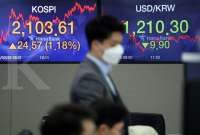Indonesia’s manufacturing sector improved in April at their fastest rate in almost a year as Southeast Asia’s largest economy continued to grow, boosting demand; however, actual output fell, according to the latest survey.
The HSBC Manufacturing Purchasing Managers’ Index (PMI), which surveys more than 400 manufacturing companies in the country on a monthly basis, was at 51.1, up from 50.1 in March, the highest level since May last year. The PMI is a composite index based on five indicators, namely new orders, output, employment, suppliers’ delivery times and stock of items purchased. An index reading of more than 50 indicates an overall increase.
Incoming new orders grew faster, while staffing numbers and stocks of purchases returned to growth in April, all of which supported the PMI reading.
“The PMI was surprisingly strong in April, and the breakdown suggests the pickup was driven more by an improvement in domestic demand,” Su Sian Lim, ASEAN economist at HSBC, said in a press statement after the data release on Friday.
“Overall, new orders rose more strongly. Other sub-components of the PMI also improved more than expected — employment increased for the first time since July 2013, albeit marginally — while stocks of purchases returned to growth,” she added.
“This means that in the next few months demand will pick up,” said Purbaya Yudhi Sadewa, chief economist at the Danareksa Research Institute.
Data from local banks also show higher demand for funding in the first three months of this year as lending by Indonesia’s major lenders grew.
State-owned Bank Negara Indonesia (BNI) booked 23.3 percent loan growth in the first quarter of this year from the same period last year, while Bank Mandiri, Bank Rakyat Indonesia (BRI) and Bank Central Asia (BCA) each saw its lending grow by between 19 and 20 percent.
“Although demand is strong, the pace of growth remains questionable,” Yudhi added.
The country’s economy grew the slowest in four years at 5.78 percent in 2013, and policymakers are finding ways to boost the economy against the backdrop of a bleak global economic outlook, especially with a slowdown in China, which is the world’s second-largest economy and Indonesia’s top export destination.
Central Statistics Agency (BPS) data, also published on Friday, supported the PMI reading, as it reported a 3.76 percent increase in production for medium and large industrial firms in the first quarter of this year compared to the same period a year ago.
“The increase was primarily driven by output growth in other manufacturing [up 17.78 percent], the pharmaceutical and traditional medicine sector [up 15.41 percent], as well as the machinery and equipment sector [up 9.73 percent],” the agency said in a press statement.
Small and micro-industrial firms’ output was also on the rise, increasing 4.41 percent from the January-March period last year to the same period this year, on the back of strong gains in the sectors of other manufacturing (18.71 percent), printing and media (11.29 percent), as well as food (8.66 percent).
“It’s good that the small and micro manufacturers posted higher growth. I hope that labor absorption will therefore be greater,” said Ahmad Erani Yustika, executive director of the Institute for the Development of Economics and
Finance (Indef). “So, the direction is right, but the magnitude has to be boosted.”
Manufacturing is the largest contributing sector to Indonesia’s economy, accounting for around 24 percent of Indonesia’s gross domestic product (GDP) in recent years, BPS data shows.
However, the sector’s contribution to the nation’s GDP has slipped from around 30 percent in the past six to seven years. “Our workforce is mostly low-skilled, so the labor-intensive sector needs to be expanded. Hence, manufacturing needs to grow even faster to enlarge the sector,” Erani said. (Ester Samboh)
Manufacturing at 11-month high as demand grows
May 03, 2014, 04.02 PM
/2011/01/21/1307573704p.jpg)
ILUSTRASI. Soccer Football - FIFA World Cup Qatar 2022 - Round of 16 - Brazil v South Korea - Stadium 974, Doha, Qatar - December 5, 2022 Brazil's Neymar celebrates scoring their second goal REUTERS/Carl Recine
Reporter: Sanny Cicilia
| Editor: Sanny Cicilia
Latest News
-
January 02, 2026, 03.24 PM
Asia Stocks Start 2026 Strong; Taiwan, South Korea & Singapore Hit Records
-
December 31, 2025, 10.53 AM
GLOBAL MARKETS-Asian Stocks Set for Strongest Annual Jump in Eight Years on AI Bets
-
December 31, 2025, 05.38 AM
Wall Street Closes Slightly Lower Near The End of a Banner Year; Gold Rebounds
-
December 30, 2025, 04.46 PM
Indonesia's Free Meal Scheme to Reach 80 Million Recipients by April, Behind Target
-
December 29, 2025, 10.13 PM
Wall Street Falls as Tech Rally Falters in Final Week of 2025
-
December 29, 2025, 02.23 PM
Asian Stocks Rise, Precious Metals Hit Records on Fed Rate Cut Bets
-
December 27, 2025, 04.19 PM
Moscow Sentences Russian Diplomat to 12 Years for Passing Secrets to U.S Intelligence
-
December 24, 2025, 05.47 PM
MGMC 2025 Highlights Moscow’s Global MICE Readiness—Can Indonesia Follow?
-
December 24, 2025, 05.17 AM
GLOBAL MARKETS-Equities Rise after Strong US Data, Yen Firms on Currency Warnings








